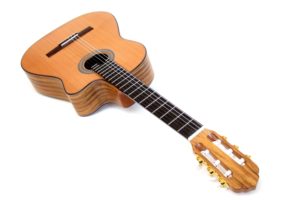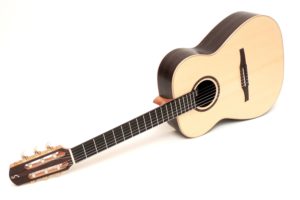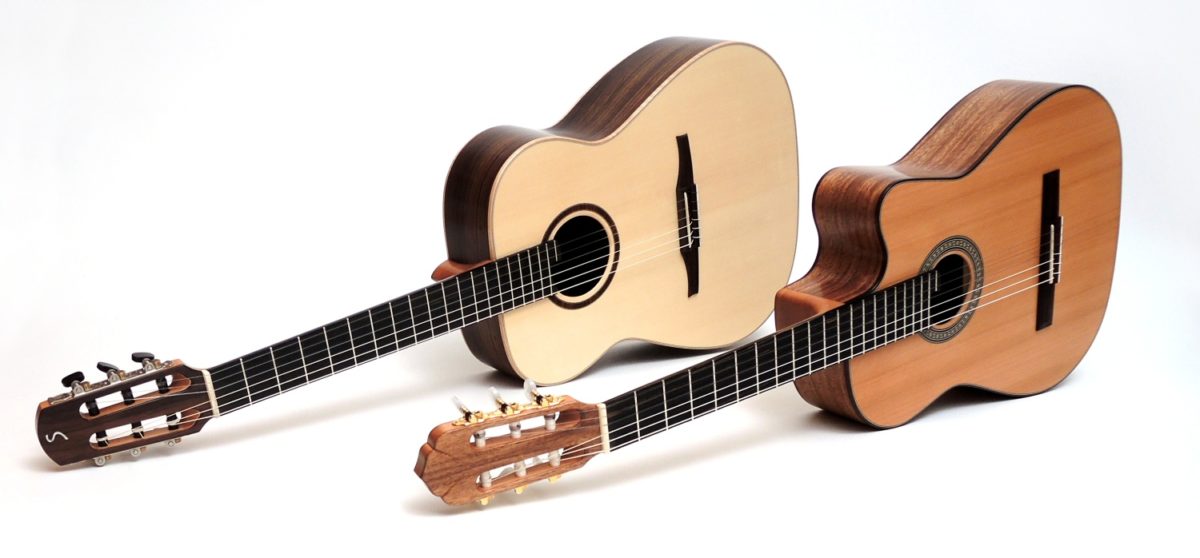Crossover guitars are characterised by a feature combination of classical and steel string guitar.
Crossover Concept
Crossover guitars are born out of the need to adapt the playability of a certain guitar to the personal playing habits that a player has acquired on a guitar of a different genre. The most common case is that a steel string guitarist has difficulty playing the classical guitar.
To understand the crossover concept, it is necessary to know the major differences in the construction of classical and steel string guitars.
| Classical Guitar | Steel String Guitar | |
|---|---|---|
| # Frets Clear of Body | 12 | 14 |
| Neck Profile | flat D | more round, C shape |
| Body Design | classical, marginal derivations | variabel, from very small (parlour) to very large (jumbo) |
| Bracing | fanned | x-bracing |
| Head | slotted | solid |
| Bridge Position | centered | off center, closer to the sound hole |
| Fingerboard | wide and flat | narrow, curved |

Crossover - Playability
The most simple type of a crossover guitar is the classical guitar with cutaway. The cutaway makes it easier for the steel string guitarist to play the upper registers. Often, the string action is kept lower than with the usual classical guitar. For the classical hand position, a comparatively wide neck with a flattened D-profile is needed. The fingerboard is flat too. Since this hand position is not the right choice for every guitarist, the neck profile is often changed and the neck is made narrower. Sometimes the fingerboard is also curved.
Crossover - Sound
If the playability is adjusted, in a second stage, the bracing is adjusted. It no longer serves the typical classical sound ideal, but is designed to produce more modern sounds like bossa, latin, jazz etc. Our model Alegra is a good example for such a guitar. Often, it is also equipped with a pickup for better performance in a band context.
Crossover - Body
Another mutation stage is the transfer of the neck-body transition to the 14th fret. This way the playability in the higher positions is improved.
The longer neck creates more leverage, making it more likely to warp. Therefore, a good luthier should not make such a change without considering a truss rod.
The bridge of classical guitars is positioned in the center of the vibrating part of the top. Thus, the sound can be transported to the outside in the best possible way. When building a 14-fret guitar, the bridge is moved from the center of the top in direction of the sound hole. Regardless of the type of guitar, this measure makes the guitar sound quieter and flatter at first.
With 14-fret steel string guitars the luthier frequently tries to compensate this shortcoming by body size and bracing. Often this is at the expense of a tonal balanced sound shifting towards the bassy frequencies. Only very few luthiers have dared to question the classic form, which is why nylon string crossover guitars are usually balanced by adjusting the bracing only. It should be obvious, that this often may result in a tonal setback.
Crossover - Sophisticated
If you want to get a crossover nylon string guitar with excellent sound, radical action is needed. One of these measures is a drastic enlargement of the body. Due to the extended surface of the top, it is now possible to move not only the bridge but also the sound hole upwards. This way a central positioning of the bridge is possible.

In order to achieve a harmonious vibration of the top, the interior construction must be adapted to the changed proportions. Due to the larger surface, the balance of forces around the strings is changed. Therefore, the traditional classic fan bracing must be completely reconsidered. The X-Bracing is not an option here, as it was developed for a string tension that is about twice as high as that of nylon strings. On a crossover guitar in the style described here, this would have a rather killing effect.
In terms of bracing, the luthier has to rely on his experience and intuition to elegantly solve this problem. If everything is done right, these changes will result in a full, luscious sound, rich in overtones. Such a crossover guitar can be even louder than a normal classical guitar and yet have a large dynamic range, which responds to soft sounds as pure and selective as to powerful playing. Combined with the already mentioned changes of string position, neck width and neck profile this way one can create a nylon string guitar, which has a surprisingly high steel string feel.
Crossover - Variations
The crossover world is populated by much more varieties of their genre. One can find for example the classic body with "modern" bracing or the 14-fret transition without any other changes or a larger body without cutaway. The placement of the sound hole on the side of the top or in the sides is a measure that is often performed on crossover guitars.
It should not go unmentioned, that sometimes also steel string guitars with classical guitar properties are built. These are characterised e. g. by a wide neck, little or no fingerboard curvature or a neck profile which is almost classical.
Classic guitarists often coose our model Ambition Fingerstyle. You will find classical guitar features like the transition on the 12th fret, the resulting centered bridge, the wide neck and the slotted headstock.
STOLL Goes Crossover
Our Models Alegra and Classic Crossover cover the crossover spectrum, from the "simple" nylon string guitar with cutaway and modified sound characteristics to the sophisticated supermodel with neck-body transition at 14th fret and an enlarged body.
For reversed crossover our model Ambition Fingerstyle is highly suitable.

